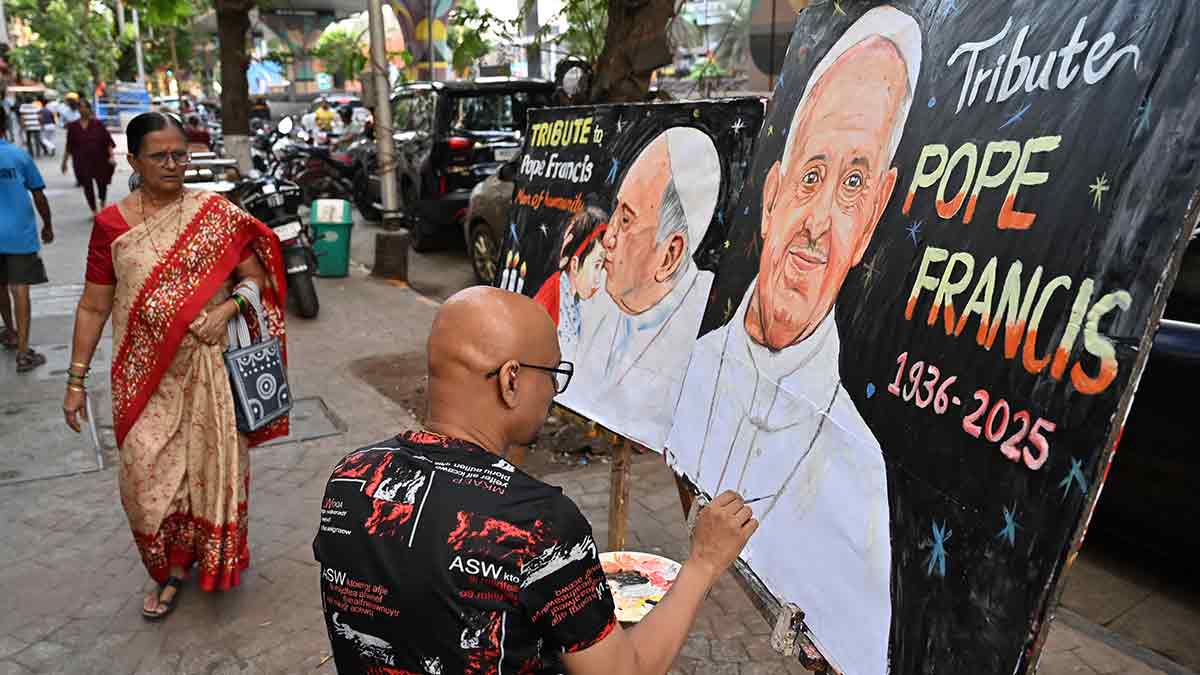A Pope who pushed for an international audit system in the Vatican
 Etched in memory: Artist Sagar Kambli paints the image of Pope Francis | Amey Mansabdar
Etched in memory: Artist Sagar Kambli paints the image of Pope Francis | Amey Mansabdar
I HAD THE privilege of working alongside Pope Francis long before the world knew him by that name. To me, he was Cardinal Jorge Mario Bergoglio. As I look back on my 13 years at the Vatican―from 2009 to 2022―working on the Malayalam edition of Vatican News, I feel nostalgic and proud.
I lived on the second floor of a serene Vatican residence called Domus Internationalis, very close to the Roman Senate. In 2010 I stayed in Room 211, and by sheer chance I came to know Cardinal Bergoglio, who lived in Room 205. Occasionally I used to carry his bag, as he had a small trouble with his leg.
Cardinal Bergoglio loved the house. He was a broad-shouldered, kind man who cherished solitude. Often I would find him deep in prayer at the chapel in the residence. Once I invited him to join us for breakfast. He smiled and declined, saying he didn’t usually eat breakfast, but instead he welcomed me into his room for a cup of coffee.
When the white smoke rose from the Sistine Chapel in 2013, signalling the election of a new Pope, I was in tears as I saw Cardinal Bergoglio emerge on the Central Balcony of St Peter’s Basilica. Dressed in a simple white cassock, in his calm, slow Italian, he addressed the world. It was a deeply moving moment―my friend was now the Pope.
Though I had fewer opportunities to speak with him after he became the Pope, I closely followed his journey― and his attempts to build a new, reformed church.
Pope Francis set the tone for his papacy by declaring the Extraordinary Jubilee Year of Mercy in 2016. He surprised the world by opening the Jubilee Year not in the pomp and glory of Rome, but in a modest chapel in one of the poorest parts of Central Africa. It was a powerful gesture that showed his commitment to a Church that is simple and inclusive―a church that truly walks with the marginalised. The same year, he canonised Mother Teresa as a saint―a proud moment for Indians.
What stood out to me was how Pope Francis pushed for a deep renewal of the Church, starting with financial reforms. He introduced an international audit system―something unheard of in Vatican history―and managed to get on board even those cardinals who were hesitant. He also streamlined the Vatican’s media operations and, in a first, appointed a layperson to head it. The reforms he introduced spanned various departments, from liturgy to humanitarian work to the powerful Vatican Secretariat.
He led by example. Rather than move into the grand Apostolic Palace, Pope Francis chose a modest residence in Santa Marta. It had only a small office, a simple living room, and a modest reception area. The simplicity reflected his values.
Pope Francis reached out to people who were often marginalised by the Church, like homosexuals―not to endorse any particular lifestyle but to show compassion and understanding. Although he faced some criticism for it, he believed mercy and forgiveness should be part of the Church’s daily life.
He spoke strongly against the destruction of nature and the indifference people show towards it. He even called environmental neglect an “ecological sin” warning that if we don’t act together, we could perish together. He often spoke of caring for the Earth as a spiritual duty.
The Pope had a lifelong love for football―he played it as a young man and stayed connected with the game even as a priest, bishop, and later, as Pope. He was the official confessor for the Argentinian national team before his elevation to the papacy and shared a warm bond with players like Maradona, who would visit him at the Vatican, often gifting him jerseys, including the iconic No. 10. Other football stars like Ronaldinho and Messi also visited him, and Latin American teams would often stop in Rome for a blessing before major tournaments. His love for the game even led him to launch Scholas Occurrentes, a global initiative that began in Argentina and now spans over 90 countries, promoting sports, cultural exchange, and youth empowerment.
I recall a deeply personal moment when Pope Francis shared how much he admired India and Mahatma Gandhi. He often spoke of Gandhi’s principles of compassion and Ahimsa, and I truly believe he was Gandhian at heart. He wanted to visit India, especially Gandhi’s home and Samadhi, but sadly that wish did not come true.
His final wish was to be buried in the Basilica of Saint Mary Major, a place he held close to his heart. I remember March 13, 2013―the day he became Pope. The first place he visited was this Basilica. He sat quietly in front of the icon Salus Populi Romani (Salvation of the Roman People), deep in prayer. He would visit the church before and after every international journey―sometimes bringing flowers, sometimes even a football, as an offering to Mother Mary.
Fr William Nellikal is the parish priest of St Antony’s Church in Panangad, Kochi, Kerala.
―As told to Jose K. George
The Week